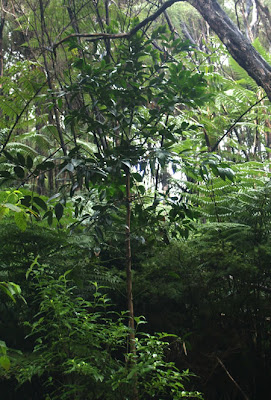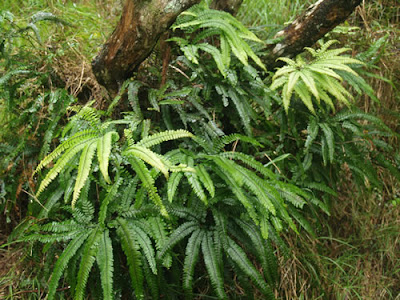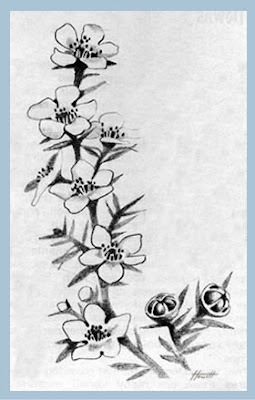
Wild New Zealand Zoo
Saturday, August 13, 2022
Saturday, April 21, 2012
Polynesians Explore the New Zealand Bush.
Taketakerau The Millennium Tree : The Art - Illustrations
One of my illustrations for this book, which describes the history of Aotearoa New Zealand in relation to a 2000 year old Puriri tree (still extant) that was for many centuries used as a burial tree by the local Maori tribe. Here, the Polynesian migrants explore the native forest and bush, finding birds and plants entirely new to them.
One of my illustrations for this book, which describes the history of Aotearoa New Zealand in relation to a 2000 year old Puriri tree (still extant) that was for many centuries used as a burial tree by the local Maori tribe. Here, the Polynesian migrants explore the native forest and bush, finding birds and plants entirely new to them.
Wednesday, February 1, 2012
The Kokako or Blue-Wattled Crow
One of our victories in the fight against extinction of native New Zealand species is the North Island Kokako or Blue-wattled crow (Calleas cinerea - endangered). Up here in the North, they have been re-established in the Puketi Forest, close to where I live, though I don't get them on this property.
The Kokako is quite an amazing-looking bird with blue wattles (the presumed-extinct South Island Kokako had orange wattles), a strong beak and quite a large body:
This is a detail from a painting called "Dawn Chorus" that I did last year as one of a series of 36 artworks to illustrate the recently-published book "Taketakerau The Millennium Tree".
Enjoy!
Patricia
http://patriciahowitt.com
http:..taketakerau.com
The Kokako is quite an amazing-looking bird with blue wattles (the presumed-extinct South Island Kokako had orange wattles), a strong beak and quite a large body:
This is a detail from a painting called "Dawn Chorus" that I did last year as one of a series of 36 artworks to illustrate the recently-published book "Taketakerau The Millennium Tree".
Enjoy!
Patricia
http://patriciahowitt.com
http:..taketakerau.com
Saturday, October 22, 2011
Spring Has Sprung in the Far North
Spring and the start of summer are definitely with us this Labour Holiday Weekend, in spite of some patches of nasty cold weather this last few weeks. The grass is coming away, trees and bushes are in bud and bloom, and the birds - well, they are full into the 'silly season'.
I'm quite sure my decision to allow the back paddocks to go back into bush was the right one to make. And because of it, I am equally sure there are many more birds around the place.
Coming home from town a few days ago I caught sight of a couple of kereru (Hemiphaga novaeseelandiae) perched on the power lines a little further down the hill. Most of our native birds are protected and I only hope human predators leave them alone. If you don't know about our Native NZ Pigeon, here is a detail from a painting I've done for the upcoming book, 'Taketakerau - The Millennium Tree":
Click here for more details about this book, due for publication in New Zealand in early December.
Yesterday I heard for the first time in ages the call of the native Kingfisher - (Halcyon sancta vagans) - the kotare. What joy - I haven't had one on here for years. And I've several times heard the characteristic 'wham' as a bunch of California Quail (Callipepla californica) takes off from the undergrowth into cover. Takes me back over 30 years to when I used to visit at Christmas. But they've been rather scarce lately.
The swallows who roost on the big beam in my carport (and make a huge mess on the concrete floor) have raised their first brood already, and it always amazes me how quickly these little balls of fluff take to the air. Already the whole family is scything its way through the ether above the concrete pad and the paddock below the house.
I'm sure I have more tuis (Prosthemadera novaeseelandiae) also. I don't often see these birds in full song - they normally give voice from somewhere up in the pines or the cryptomerias, but last week one was shouting his joy from a Coral Flame Tree in the back garden. He must have been taking nectar from the brilliant red flowers that are out right now, and he was sitting on the bare branches chortling and sneezing. Exactly the same actions and sounds (except no human words) as the late WoofWoof from the bird sanctuary in Whangarei - see video above.
The only birds I wish I didn't have are the Indian Mynahs. I wonder how many times this country has regretted importing them (and many other species). With the illustration job I've been doing, I didn't have time to block the holes they use for nesting up high in the a-frame cottage this year - after they've finished, I must get to that job!!
Patricia
http://patriciahowitt.com/
Labels:
birds,
kingfisher,
mynah,
native NZ pigeon,
reforesting,
spring,
summer,
tui
Monday, August 15, 2011
Native Forest Regeneration Process 2
Just by way of illustration of my previous post, here is a photo of an Australian Kauri (Agathis robusta) - one of three I planted below the kanuka canopy in my gully paddock last summer. They were above my head when I put them in and they're racing away now:

You can see below it the shiny, bright green leaves of a very common native shrub called hangehange (Geniostoma ligustrifolium), also taking advantage of the shady conditions to get itself established.
Where there are breaks in the overhead canopy, a few gorse bushes still persist, but they certainly don't look very healthy. Here's another photo of one of our native maidenhair ferns (Adiantum cunninghamii) self-sown and flourishing beautifully at the foot of a kanuka tree:

Patricia

You can see below it the shiny, bright green leaves of a very common native shrub called hangehange (Geniostoma ligustrifolium), also taking advantage of the shady conditions to get itself established.
Where there are breaks in the overhead canopy, a few gorse bushes still persist, but they certainly don't look very healthy. Here's another photo of one of our native maidenhair ferns (Adiantum cunninghamii) self-sown and flourishing beautifully at the foot of a kanuka tree:

Patricia
Native Forest Regeneration Process
Most people hate gorse, and having dealt with it on this property for over 40 years since my parents bought the place, so do I. Amazing how this plant, imported to form neat hedges in the early days of colonization, went rampant and took over the countryside. Or maybe forseeable, if only people had thought of the very different climatic conditions here, when they brought the plant in.
Gorse is pretty indestructible, because of the viability of its seed. On the good side, it has a very deep root system and being of the lupin family, it does have nutriment to add to the soil in the form of nitrogen and other goodies no doubt. On the bad side, you can slash it to the ground and it will cheerfully grow again.
It does have the advantage in that it makes a great nursery system for native plant seedlings growing underneath it. Its other advantage is that without direct sunlight, it dies out. So voila - we have a useful succession process, which of course is not instant (but then nature is NOT an instant fix).
Most often, the first seedlings to sprout under the gorse are kanuka (Leptospermum ericoides) and manuka (Leptospermum scoparium) - often referred to as "scrub" by those who unfortunately know no better.

Kanuka especially grows to a good height and in time overtops the gorse, which dies out, leaving a great shady coppice for the regeneration of larger native trees.
It's a great system, and all it requires is a little patience. Just think - you can even be rearing up some seedlings of other native trees ready to plant under there, once the gorse starts thinning out.
Patricia
Photos: Some of my regenerating forest.
Gorse is pretty indestructible, because of the viability of its seed. On the good side, it has a very deep root system and being of the lupin family, it does have nutriment to add to the soil in the form of nitrogen and other goodies no doubt. On the bad side, you can slash it to the ground and it will cheerfully grow again.
It does have the advantage in that it makes a great nursery system for native plant seedlings growing underneath it. Its other advantage is that without direct sunlight, it dies out. So voila - we have a useful succession process, which of course is not instant (but then nature is NOT an instant fix).
Most often, the first seedlings to sprout under the gorse are kanuka (Leptospermum ericoides) and manuka (Leptospermum scoparium) - often referred to as "scrub" by those who unfortunately know no better.

Kanuka especially grows to a good height and in time overtops the gorse, which dies out, leaving a great shady coppice for the regeneration of larger native trees.
It's a great system, and all it requires is a little patience. Just think - you can even be rearing up some seedlings of other native trees ready to plant under there, once the gorse starts thinning out.
Patricia
Photos: Some of my regenerating forest.
Sunday, August 14, 2011
Forest Giant
The forest on the steep land above my house is, I think, pretty much untouched. It's mostly tarairi (Beilschmiedia tarairi), kohekohe (Dysoxylum spectabile) and nikau (Rhopalostylis sapida) with totara (Podocarpus totara) mixed in and the odd rewarewa (Knightia excelsa) here and there. It was a burial place for many years, having at least one deep sinkhole in the limestone rock beneath the volcanic peak, though the tapu has since been removed.

I've been involved with this place since my parents first bought it in 1970, and it's been a huge inspiration over the years, even more so now that I am living here full time.
My dream is to put my 10 acres back into forest - just think how much more life can be supported by 10 acres of forest than can live on 10 acres of steep, struggling pasture. Right now, the gorse is flourishing, but in the gully paddock directly above my house, 30' kanuka (Leptospermum ericoides) has taken over, the gorse is gone, there's a wonderful understorey of mamaku and native seedlings coming up, and it's a beautiful place to wander in.
Birdlife is more abundant already. Ride on, Tane!

I've been involved with this place since my parents first bought it in 1970, and it's been a huge inspiration over the years, even more so now that I am living here full time.
My dream is to put my 10 acres back into forest - just think how much more life can be supported by 10 acres of forest than can live on 10 acres of steep, struggling pasture. Right now, the gorse is flourishing, but in the gully paddock directly above my house, 30' kanuka (Leptospermum ericoides) has taken over, the gorse is gone, there's a wonderful understorey of mamaku and native seedlings coming up, and it's a beautiful place to wander in.
Birdlife is more abundant already. Ride on, Tane!
Labels:
forest,
kohekohe,
native,
nikau,
regeneration,
rewarewa,
tarairi,
totara,
wilderness
Subscribe to:
Posts (Atom)

